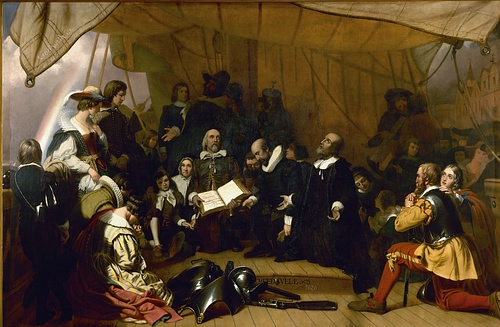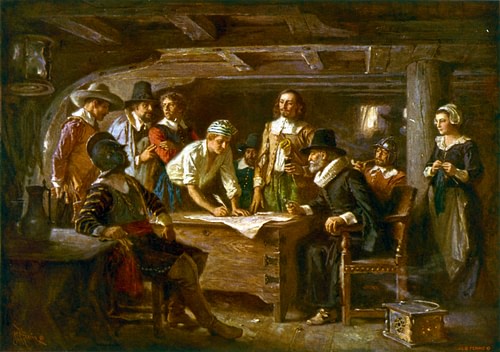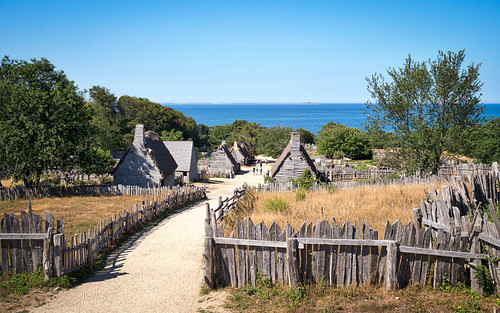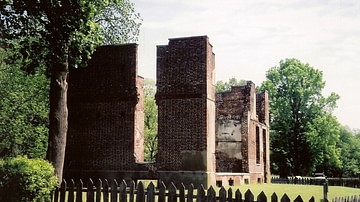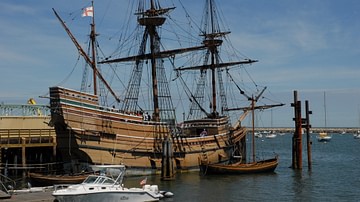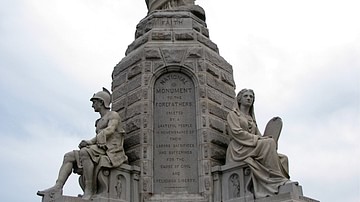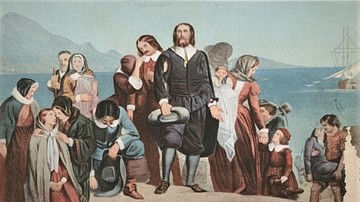
Stephen Hopkins (l. 1581-1644 CE) was a passenger of the Mayflower on the voyage of 1620 CE which established the Plymouth Colony in present-day Massachusetts, USA. He was the only member of the party with prior experience in North America, having taken part in a mission to supply the Jamestown Colony of Virginia in 1609 CE. The ship he was traveling on, the Sea Venture, was wrecked on the coast of Bermuda, stranding the company there for the next ten months until they completed the construction of two ships which brought them to Jamestown in 1610 CE. The wreck of the Sea Venture, chronicled by one of the passengers, William Strachey (l. 1572-1621 CE), provided the inspiration for William Shakespeare's play The Tempest (written 1610-1611 CE), and one of the characters, Stephano, is believed to be based on Hopkins.
He served as an indentured servant at Jamestown before returning to England in 1614 CE upon receiving news of his wife's death, remarried, and signed on to the Mayflower expedition in 1620 CE traveling with his second wife, children, and servants. He was one of the signers of the Mayflower Compact, took part in explorations of the region to find a place for settlement, and afterwards participated in diplomatic missions to the Native American settlements of the Wampanoag Confederacy.
Hopkins seems to have been well acquainted with Native American culture, practices, and some of the language from association with the Powhatan Confederacy of Virginia. He is mentioned by William Bradford (l. 1590-1657 CE), second governor of the colony, in his Of Plymouth Plantation as an active member of the community, and he is one of the Strangers (rather than as a Saint, a member of the religious separatists who initiated travel to North America) most frequently referenced. He is known to have operated a tavern (known as an “ordinary”) in the colony and was fined a number of times for, among other infractions, his liberal policies in allowing people to drink there on the sabbath. Even so, he remained a citizen in good standing, serving as assistant to the governors, until his death in 1644 CE.
Early Life
Hopkins was born in Hampshire, England, to John and Elizabeth (nee Williams) Hopkins and baptized at Upper Clatford in 1581 CE before the family moved to Winchester where his father died in 1593 CE. He was the second of four children of a lower-class family (his father was a tenant farmer who worked others' lands) which was still affluent enough to allow for Hopkins' education at a petty school (an informal institution which taught the basics) before graduating to a grammar school. This claim is supported by evidence that Hopkins continued his education even after his father's death, which would not have been possible for a family without means.
According to scholar Jonathan Mack, he seems to have gone on to attend Winchester College, which had an outreach program that provided education to promising students of the lower class. Hopkins' later position as cleric's assistant to Jamestown seems to have been due to the headmaster of Winchester College, one John Harmar, who was also initially of the lower class. Mack comments:
Whatever the case may have been, there is substantial indirect evidence that Hopkins had at least some type of tutelage in grammar school, for he would later be chosen as clerk to the Anglican chaplain of the Virginia settlement. In that era, a minister's clerk had to be literate, as one of the three primary duties was to read aloud a portion of an epistle for the service, which was likely delivered in both Latin and in English, and to sing from the Psalter. Indeed, it wasn't unusual for a clerk to possess an education on par with the minister himself. (4)
By 1605 CE, he had moved to Hursley, near Winchester, was married to Mary Kent, and had a young daughter named Elizabeth. At this time, he worked as a tenant farmer and helped his mother-in-law running an alehouse. Between 1605-1608 CE, the couple had two more children, Constance and Giles, and Hopkins had to find better means to provide for them. Possibly owing to a recommendation from his old headmaster Harmar, he was given the much sought-after position of assistant to the Anglican priest Richard Buck who was being sent as chaplain to Jamestown.
Hopkins left on the supply mission in June 1609 CE with an armada commanded by Sir George Somers (l. c. 1554-1610 CE) which was not only carrying supplies and colonists but the new governor Sir Thomas Gates (l. c. 1585-1622 CE). Hopkins sailed aboard the Sea Venture with the more prominent members of the expedition as assistant to Buck.
Bermuda & Jamestown
In July 1609 CE, the armada was separated by a storm which threatened to sink the Sea Venture. Land was sighted as the ship was taking on water, and it was driven onto the reefs off Bermuda. The islands of Bermuda were known to the sailors as the Isle of Devils, first discovered in 1505 CE by the Spanish explorer Juan de Bermudez (d. 1570 CE) but was never colonized owing to strange sights and sounds reported by the crew who interpreted what were most likely tropical birds as demons and devils. These reports, along with Strachey's account of the storm and Sea Venture's wreck, would inform Shakespeare's The Tempest.
Based on these tales, the castaways were initially afraid of every sound they heard until they realized the land was a paradise of fresh fruit, water, game, and completely uninhabited. A temporary settlement was built while a small boat was equipped for sea voyage and sent off with a party to bring help from Jamestown. The boat never returned and, with no help coming, Gates organized the passengers – which included sailors, laborers, gentlemen, and two Native Americans who were returning to Virginia – into groups to build two ships.
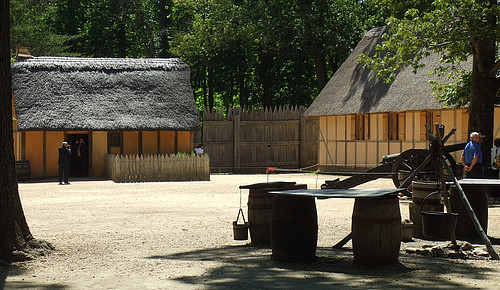
In January of 1610 CE (according to the account by Strachey), Hopkins confided to two others on his work detail that, since they were in Bermuda, not Virginia, Gates had no authority over any of them because his orders were only valid in Jamestown. They could, therefore, refuse to obey him, in good conscience, as they were under no law and could choose to live in Bermuda only for themselves and their families.
The two men reported Hopkins to the authorities, and Gates had him clapped in irons and ordered him hanged. Gates understood that what Hopkins had said was true, and it is precisely for this reason that he had to be silenced for the sake of order. Hopkins' pleas for mercy – as well as those by Strachey, Somers, and other leading men – convinced Gates to pardon Hopkins, who afterwards held his tongue and performed his duties without complaint. In May of 1610 CE, the party sailed in their newly built ships for Jamestown.
The new arrivals found Jamestown in near ruins. The colony's strongest leader, Captain John Smith (l. 1580-1631 CE) had left for England in October 1609 CE, and the settlement had degenerated since. During the winter of 1609-1610 CE, the settlers had resorted to cannibalism just to survive, and even by May of 1610 CE, they were still struggling, even burning their homes for fuel. Gates decided to abandon the settlement and return to England, and the ships were making their way downriver when they were met by a fleet carrying the nobleman Thomas West, Lord De La Warr (l. 1577-1622 CE), who ordered them to return to the colony and fix the problems.
De La Warr reorganized Jamestown and Hopkins remained as an indentured servant there, still attached to Buck, until 1614 CE when he received word that his wife had died. Having completed his service, he returned to England, collected his children from the families they had been placed with, and moved to London where he married Elizabeth Fisher.
The Mayflower Voyage & Compact
When Hopkins had left England in 1609 CE, he was a poor laborer but now, in 1614 CE, was an experienced colonist of status and some degree of wealth as he was able to afford servants. He may have worked as a tanner at this time before signing on to return to North America aboard the Mayflower. The Mayflower expedition was being financed by the Virginia Company, the same which had established Jamestown, through negotiations by the merchant adventurer Thomas Weston (l. 1584-c. 1647 CE) and members of a religious separatist congregation living in Leiden, the Netherlands. The separatists had fled England for Leiden to escape persecution by King James I of England (r. 1603-1625 CE) owing to their rejection of the policies and practices of the Anglican Church. Since King James I was the head of the church, any criticism of the institution was considered treason.
Weston originally made a deal with the separatists to transport them alone to North America, but as negotiations went on, he came to believe they were too inexperienced to establish a profitable colony and so invited and hired some people who could provide valuable skills and experience to join the expedition; one of this number – the people who would be known as Strangers by the separatists – was Hopkins.
The separatists sailed from Leiden aboard a passenger ship they had purchased, the Speedwell, and met up with the Strangers, as well as the cargo ship Weston had rented for them, the Mayflower, in Southampton, England. The two ships started out together for North America in mid-summer, but the Speedwell repeatedly leaked and had to be abandoned, requiring some of its passengers to board the Mayflower. The separatists (who referred to themselves as Saints) and the Strangers, numbering 102, began the voyage again on 6 September 1620 CE, all cramped together in the 'tween deck of the cargo ship for over two months. Mack comments:
Gossip and games and storytelling would likely have been the most common diversions available to passengers. On the Mayflower, Stranger and Saint alike would probably have started to share information about themselves as they started the adventure of their lives together. Of course, word probably spread quickly that this was not Stephen Hopkins' first time in North America. He likely would have been encouraged by his shipmates to share the tales of some of his prior experiences. (63-64)
One of these experiences, Mack argues, was the conversation on Bermuda leading to his arrest and near execution, which may have given some others on board the idea to voice the same concerns later. The Mayflower was blown off course, finally sighting land off Massachusetts on 9 November 1620 CE, not Virginia where their patent held and English law was established. Bradford relates how some of the Strangers on board noted this and claimed how, once ashore, they would live as they pleased because no law could compel them to behave any differently; exactly the argument Hopkins had voiced in Bermuda.
This objection necessitated the composition and signing of the Mayflower Compact on 11 November 1620 CE, an agreement that established a democratic form of government in which every male over the age of 21 would have a vote. After the agreement was signed by 41 of the men on board, Hopkins among them, the newly elected governor John Carver (l. 1584-1621 CE) gave assignments, and exploration of their new home began. Mack and others argue against Hopkins as the instigator of the dispute, noting he had far more to lose this time and had already learned his lesson earlier.
First Winter & Native Americans
Between 11 November and 21 December 1620 CE, expeditions were launched from the Mayflower to find a suitable place for the new settlement, and Hopkins participated in a number of these which were usually led by Captain Myles Standish (l. c. 1584-1656 CE) and included others such as Bradford and Edward Winslow (l. 1595-1655 CE). Bradford reports that Hopkins was able to identify Native American hunting snares (one of which Bradford himself was caught in) and was knowledgeable on Native American customs. Hopkins was among the party which first met the Nauset tribe, who attacked them, in early December 1620 CE (known as the First Encounter), and based on his experience with rebuilding Jamestown, he participated in the decision on the site of the settlement on a hill, formerly inhabited by members of Pawtuxet tribe, which became Plymouth.
Between December 1620 and March 1621 CE, 50% of the passengers and crew died, but Hopkins and his family survived. Hopkins' son, Oceanus, had been born on the Mayflower prior to landing (the first “child of the Mayflower”), and even he survived (though he died later in 1627 CE). The colonists were still struggling in March when they were approached by the Native American Samoset (also given as Somerset, l. c. 1590-1653 CE) who spoke English and welcomed them. Samoset was entertained by the colonists and spent the night in Hopkins' house.
Shortly afterwards, Samoset introduced the settlers to Ousamequin (also known as Massasoit, l. c. 1581-1661 CE), chief of the Wampanoag Confederacy, and Tisquantum (better known as Squanto, l. c. 1585-1622 CE). Encouraged by Massasoit, Squanto taught the settlers how to survive in their new home, and a peace treaty was signed between the colonists and natives later that same month. The treaty was negotiated by Carver and Winslow, but Hopkins was among the delegation and may have assisted in translating, along with Squanto, as he seems to have had some command of the language.
The help provided by the Native Americans saved the young colony, and Hopkins joined with the others in building their settlement. By the fall of 1621 CE, according to Bradford, they had such a plentiful harvest that they feasted for three days, entertaining their Native American neighbors, an event which has come to be known as the First Thanksgiving. By this time, Hopkins had most likely already established his “ordinary” on Leyden Street, the main street of the new town, and was assisting Bradford, who had become governor after Carver's death in April.
Conclusion
Although he actively participated in the development of the Plymouth Colony, Hopkins was an independent free spirit who seems to have always pursued his own course according to his own reason. In his later years, between 1636 and 1638 CE, he was fined for allowing people to drink in his tavern and play shuffleboard on the sabbath as well as for overcharging for alcohol. He was jailed in 1639 CE for failing to honor the contract of his indentured servant, Dorothy Temple, who had become pregnant out of wedlock, when Hopkins threatened to turn her and her newborn out of his house. Considering his record of helping others, as well as his own experiences as an indentured servant, this event seems out of character but makes more sense when one understands that the child's father was one Arthur Peach, a man recently executed for the murder of a Native American without provocation, and Hopkins had shown himself repeatedly as sympathetic to the natives.
Hopkins' ties to the Native American community seem to have grown stronger than those to his fellow colonists over the years. Hopkins never joined the congregation of separatists, though he would have participated in services, and like the other Strangers of the settlement, he would have celebrated holidays like Christmas and Easter which were rejected by the puritans. Toward the end of his life, he sold off his lands around Plymouth to move closer to Native American settlements and took in a troubled young man, one Jonathan Hatch, who had been raised to hate the natives but, after his time with Hopkins, became a friend and advocate, later living and trading among them.
Elizabeth Hopkins died before her husband, leaving behind five children and two stepchildren, five of whom would go on to have families of their own. Mack comments:
Hopkins' influence lasted well beyond his death in 1644. There are an estimated thirty-five million people today who are descended from the passengers of the Mayflower. Of these, many hundreds of thousands can claim Stephen Hopkins as a forebear, which in and of itself could be considered quite a legacy. (221-222)
Throughout his life, however, without even considering the influence of his descendants, he had a significant impact on others. Strachey, a gentleman of the upper class, writes of him warmly at a time when Hopkins was a poor servant, and he made enough of an impression on others of Strachey's class in Bermuda that they secured his pardon. Bradford notes his contributions to Plymouth regularly, even during the period when he was fined, and when Hopkins sold his land and intended to move closer to the Native Americans, his request was granted by Bradford on the condition that he not separate himself entirely from Plymouth.
After his death, Bradford and Standish made sure his will was honored, and he was buried next to his late wife. The site of their graves is unknown. Although he is often overshadowed by the better-known Bradford, Standish, and Winslow, Hopkins was equally important to the success of the Plymouth Colony and is remembered especially as a friend to the Native Americans from the first night he welcomed Samoset into his home.
